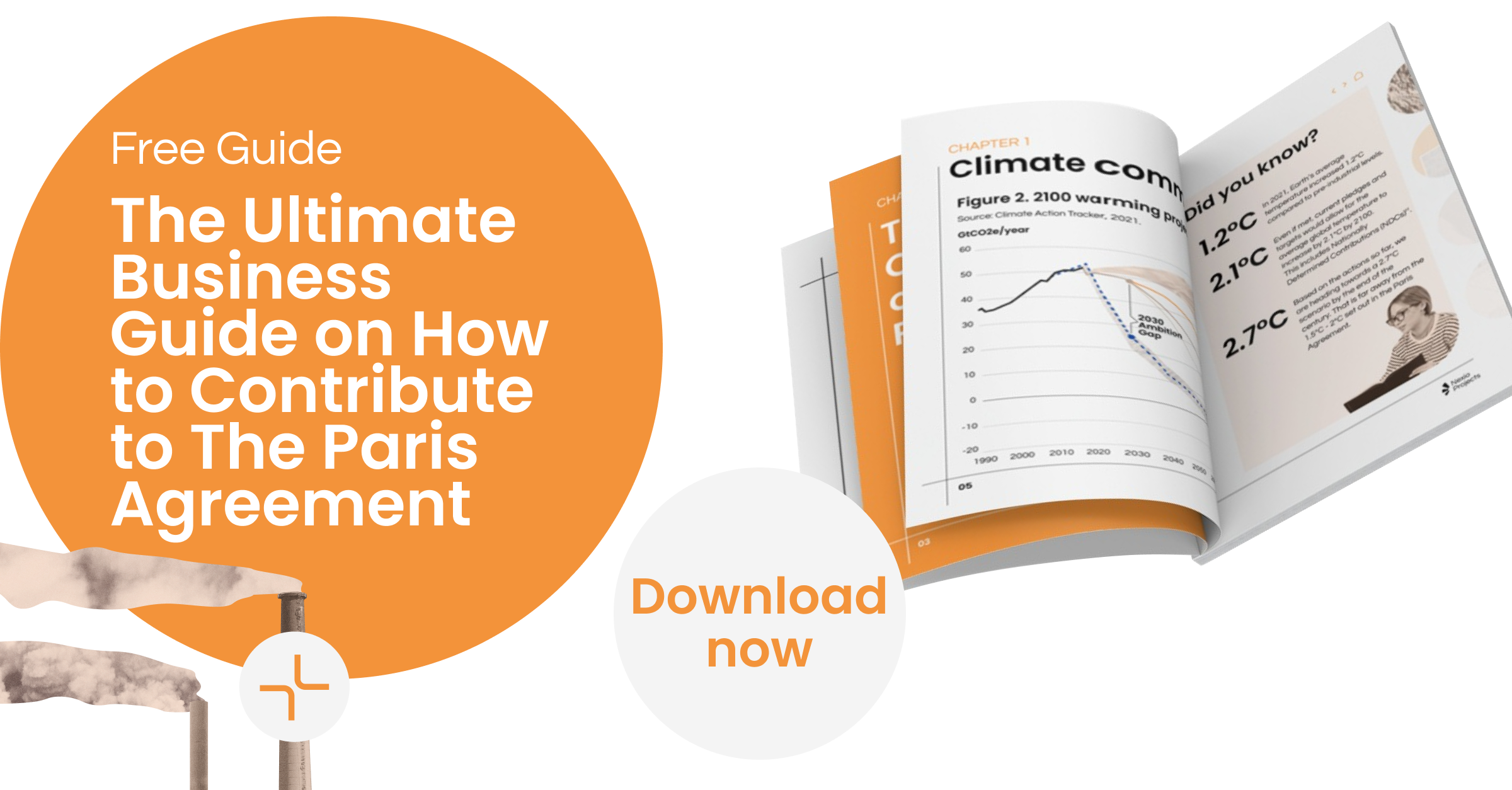Ultimate Guide for Business: How to Contribute to The Paris Agreement

Table of Contents |
Introduction
Kyoto Protocol, Paris Agreement, Glasgow Climate Pact ... so many different climate change negotiations and treaties have been developed in the last few decades.
On top of being overwhelmed by negative climate news, navigating the regulatory landscape can also be quite daunting. Therefore, we've put together an extensive article to run you through:
- The most relevant climate change agreements and treaties signed to this day;
- The best ways your organisation can align to these;
- How your organisation can effectively contribute to halting climate change.
A brief history of climate change negotiations
The first international environmental UN conference took place in 1972. As a result, the United Nations Environment Programme (UNEP) was created.
The first World Climate Conference followed in 1979 and in 1988 the Intergovernmental Panel on Climate Change (IPCC) came to life.
The IPCC was established with the aim of assessing climate change impacts and drafting mitigation actions. After the first report, published in 1990, climate change obtained greater attention on the priority agenda.
In 1994, the United Nations Framework Convention on Climate Change (UNFCCC) was founded. The main goal of the UNFCCC was to make sure that GHG concentrations wouldn't threaten human health and the climate system.
Only one year later, in 1995, all Parties to the Convention gathered for the first Conference Of the Parties (COP), which happens yearly since then.
In 1997, 192 Parties adopted the Kyoto Protocol, which, due to a long ratification process, came into force in 2005. The agreement contained binding GHG reduction targets for industrialised countries.
The successor of the Kyoto Protocol is represented by the Paris Agreement. The latter is a legally binding international treaty on climate change adopted in 2015, during COP21, by 196 Parties.
In the remainder of this article, we will explain in detail:
-
What is the Conference of the Parties;
-
What is the essence of the Paris Agreement and the following COPs' achievements;
-
How your organisation can contribute to the Paris Agreement;
-
What we should expect from further COPs.
You can also download the article in the eBook version through the link below.
CHAPTER 1
The Conference of The Parties
What is a COP?
The Conference of the Parties (COP) is the supreme decision-making body of the United Nations Framework Convention on Climate Change (UNFCCC). Or UNF triple C for short.
Its Parties, states and regional integration organisations, regularly meet to discuss the latest climate update(A).
Since 1995, the global community has been meeting on an annual basis.
Despite these regular conferences, GHG emissions have continued to increase over the past decades, as shown in Figure 1.
In fact, annual emissions rose to 51 billion tonnes of CO2 equivalents in 2018.
This is over 40% higher than in 1990 when global annual emissions were roughly 35 billion tonnes(B, C).
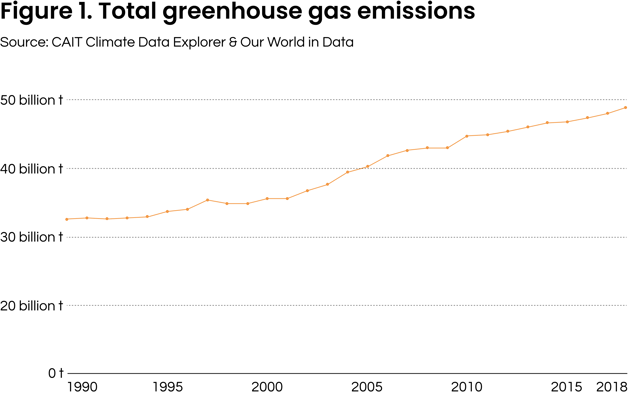
Climate Commitments
Even if met, current pledges and targets (including Nationally Determined Contributions – NDCs) would still allow for the average global temperature to rise to 2.1°C by 2100.
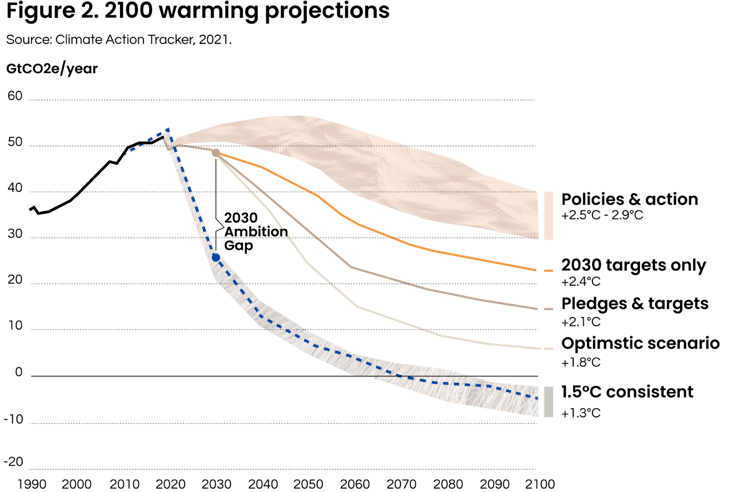
In fact, the Climate Action Tracker deems only 6% of countries’ net zero targets to be adequate (Figure 3)(D).
%201.png?width=485&height=336&name=Inadequacy%20of%20current%20targets%20(1)%201.png) A recent study by the UK’s National Meteorological Service shows a 50% likelihood that the 1.5-degree threshold will be reached in the next 5 years(E).
A recent study by the UK’s National Meteorological Service shows a 50% likelihood that the 1.5-degree threshold will be reached in the next 5 years(E).
This indicates that international climate action is failing to put a halt to dangerous climate change.
If we are not emitting any fewer greenhouse gases:
-
Did these COPs have any effect at all?
-
What has been achieved at the annual conferences over all these years?
-
And what needs to happen during the upcoming COPs for the UNFCCC to achieve its core objective?
Nevertheless, there is also reason to be optimistic. With each COP gathering, ambition levels increase and new agreements are made.
Did you know?
To frame the urgency of climate issues, the following statistics come in hand:
- In 2021, Earth’s average temperature increased by 1.2°C compared to pre-industrial levels.
- Even if met, current pledges and targets would allow for the average global temperature to increase by 2.1°C by 2100. This includes Nationally Determined Contributions (NDCs)(H).
- Based on the actions so far, we are heading toward a 2.7°C scenario by the end of the century. That is far away from the 1.5°C - 2°C set out in the Paris Agreement.
What has been achieved so far?
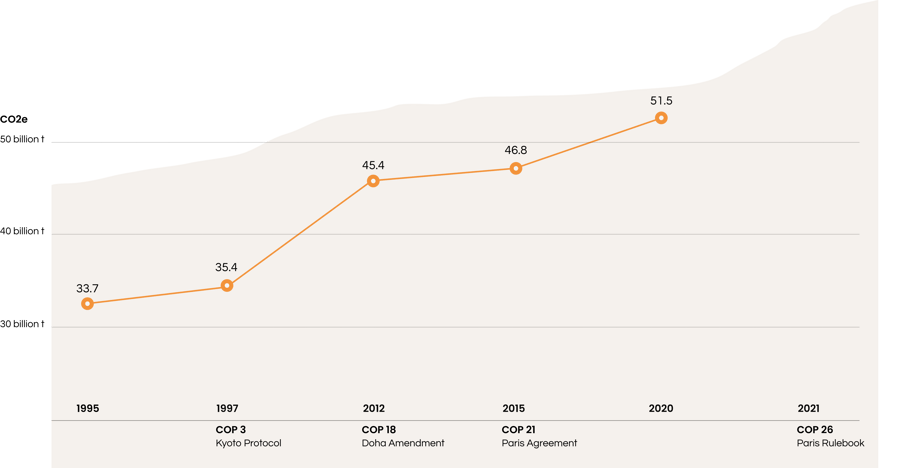
CHAPTER 2
Global Agreements to Halt Climate Change
The essence of the Paris Agreement
On the 12th of December 2015, 196 Parties at COP21 adopted the Paris Agreement. The goal? Increasing climate ambition and mobilising both developed and developing countries.
As a legally binding international treaty on climate change, its intention is to gather as many commitments as possible. Both developed and developing countries need to commit to reducing GHG emissions. These pledges must be aligned to either:
- A well-below-2°C scenario;
- An even more ambitious Science-Based Target (1.5°C);
- A Nationally Determined Contribution (NDC). This highlights the efforts the country will take to decarbonise its economy.
Simply put, the NDC of a country describes its emissions reduction plans and targets.
The Paris Agreement is the successor of the Kyoto Protocol. The latter was adopted in 1997 for global commitments to halt climate change.
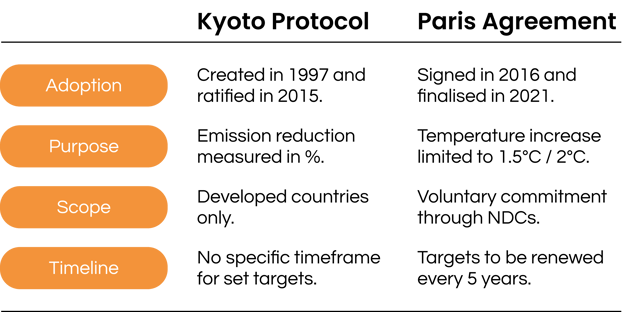
To further solidify the impact of the Paris Agreement, more robust decisions (political and technical) were needed.
These were discussed in the following COPs, eventually resulting in the Glasgow Climate Pact and further developments of the Paris Rulebook.
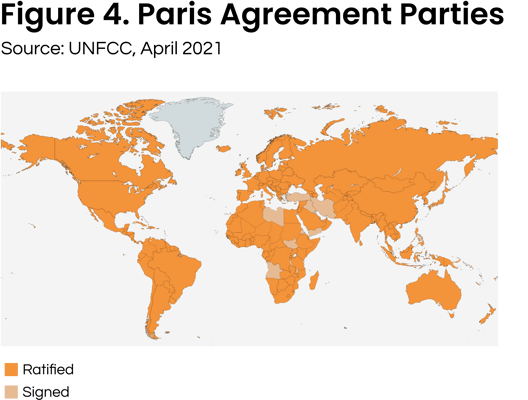
The Glasgow Climate Pact
The Glasgow Climate Pact is the final agreement of COP26. In 2021, the climate summit made important progress in furthering the targets laid out in the Paris Agreement.
National representatives from all around the world agreed to submit stronger emission reduction targets for 2030 in the next COP. This keeps the Paris Agreement’s goal of limiting global warming to 1.5°C alive.
Additionally, the Glasgow Climate Pact directed more attention to climate change adaptation and finance. It implied that developed countries would provide more resources for climate-vulnerable countries to ease adaptation.
By the end of COP26, 151 countries submitted NDCs. However, reduction targets set by many heavy-emitting countries are still too low to keep global warming below 1.5°C.
Therefore, the Glasgow Climate Pact calls on countries to:
- “Revisit and strengthen” their 2030 targets by the end of 2022;
- Align new targets with the Paris Agreement’s goal and the countries’ net-zero targets for 2050;
- Revise NDCs more often than every 5 years, putting revision on the agenda for COP27 in 2022, rather than 2025.

Article 6
One of the most important outcomes of the Glasgow Climate Pact was the finalisation of the Paris Rulebook. It was ratified six years after the adoption of the Paris Climate Agreement. The Rulebook collects a set of decisions providing details concerning the implementation of the Paris Agreement.
In its essence, Article 6 is a set of guidelines to implement international carbon trading as a means of emissions reduction. It creates a framework through which countries can develop a carbon trading system consistent with UN rules. This way, the global carbon market mechanisms are ensured to work in unison between different countries and regions.
In the final agreement of COP26, countries agreed on the shared rules regarding carbon trading systems and credits.
In particular, these rules concern:
- The eligibility of projects and activities that can be included in carbon trading;
- The approval process and issuance of credits;
- Handling of emissions reductions in each nation’s emissions inventory;
- How to deal with credits under Kyoto Protocol’s Clean Development Mechanism (CDM), a predecessor for the Paris Agreement.
Although Article 6 creates a framework for emissions trading between countries, it is not limited to trading between governments. In fact, emissions trading is most likely to happen in the private sector.
For example, one company can purchase carbon credits from another one located elsewhere to comply with national climate criteria.
.png?width=401&height=387&name=Carbon%20credits%20market%20(1).png)
All carbon credits are created by carbon projects that either reduce emissions or remove greenhouse gases. The emissions occur in one place, with the payments coming from another place.
Offset projects
For example, a company could purchase carbon credits from an organisation providing families in Cambodia with efficient biogas cookstoves. This project replaces the use of greenhouse gas-emitting wood stoves, thus lowering emissions.
The main idea behind carbon credits, or offsets, is that greenhouse gases emitted into the atmosphere quickly spread worldwide. In theory, it doesn’t matter where the carbon is emitted – or removed.
Higher-income countries could purchase carbon credits from other countries, and thereby compensate for their emissions.
The described system includes Voluntary Emission Reductions (VERs).
This is a credit where a company in one country can reduce its carbon footprint by purchasing credits from another country. However, any reductions in greenhouse gas emissions are reflected in the activities on the ground in the host country. The purchasing company cannot use these credits to meet the legal requirements set by its country of operations.
COP26 Pledges
In addition to the abovementioned outcomes of COP26, some countries committed to:

Overall, the agreements and pledges made in Glasgow’s COP26 kept the Paris Agreement’s target alive. They also show the types of changes companies can expect in the future.
As awareness grows, responsible companies can positively impact the world around them. This does not have to go at the cost of financial benefits.
Organisations could seize new market opportunities and benefit from efficiency gains through improved resource use and lower operational costs.
Understanding how to contribute toward international and national climate targets is becoming an increasingly important part of good business practices. And this is what we will cover in the remainder of the article.
CHAPTER 3
How to Contribute to The Paris Agreement?
The steps of your climate strategy
To contribute to the Paris Agreement, you need to set your climate strategy in place. Any good climate strategy is hinged on these 4 steps:
- Measure - Any climate strategy starts with measuring all the greenhouse gases that are emitted into the atmosphere as a result of the company’s operations.
- Set Targets - To meet the goals of the Paris Agreement, it is key for organisations to develop emissions reduction targets.
- Reduce - Organisations should include absolute emissions reductions. The total sum of an organisation's emissions must decrease over time.
- Offset - A carbon offset is proof of avoidance, reduction, or removal of greenhouse gas emissions elsewhere, which compensates for emissions made by the purchaser of the offset.
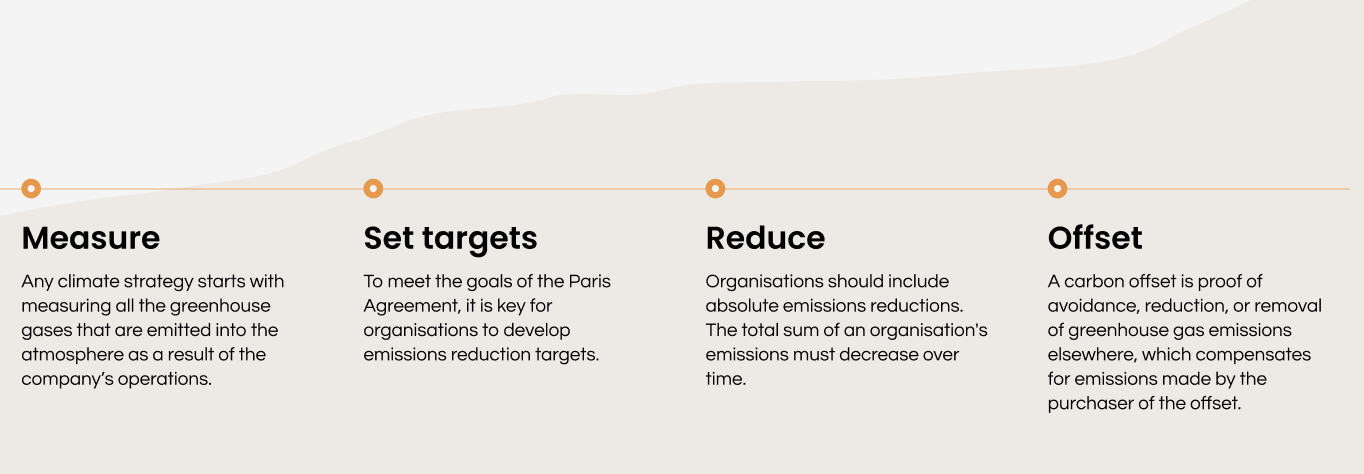
Step 1 - Measuring Emissions
The best way for companies to contribute to climate efforts is to start reducing their carbon footprint. This directly contributes to the goals and targets of the Paris Agreement. To reduce your carbon emissions, you must first understand where they come from.
For this, it is essential to start measuring your organisation’s current carbon footprint. This means quantifying all the greenhouse gases that are emitted into the atmosphere as a result of the organisation’s operations.
- Measuring emissions allows you to identify hotspots and effectively focus your decarbonisation efforts;
- Regular monitoring allows you to track progress towards reduction targets and provides information to finetune your climate change strategy;
- Proactively calculating and reporting on your organisation’s carbon footprint can improve your reputation and offer a competitive advantage;
- Measuring and setting targets signals transparency and commitment to climate actions toward stakeholders and the public;
- It helps you stay ahead of future obligatory reporting requirements;
- It helps mitigate financial risks related to future carbon restrictions and taxation.
Improved awareness within organisations can also have great impacts, such as increased employee satisfaction and process improvements. Emission reduction strategies can even be a great financial investment. Reducing energy consumption and investing in renewable energy and efficiency are ways to cut both operating costs and GHG emissions.
Many standards and methodologies exist for carbon accounting and choosing the right one can seem confusing. It is always important to follow the chosen standard’s requirements and guidelines to guarantee accuracy and transparency in reporting.
The most widely used and recognised standard is the Greenhouse Gas Protocol (GHG Protocol). It was developed by the World Resources Institute (WRI) and the World Business Council for Sustainable Development (WBCSD). The GHG Protocol is considered the gold standard framework for measuring and reducing emissions worldwide.
To accurately measure emissions, it is important to understand what the corporate carbon footprint consists of. The GHG Protocol divides emissions under three scopes:
- Scope 1 – direct emissions from owned or controlled sources;
- Scope 2 – indirect emissions from the generation of purchased electricity, steam, heating, and cooling;
- Scope 3 – all other indirect emissions that occur throughout a company’s value chain, which are split into 15 different categories.
These include emissions resulting from business travel, upstream and downstream transportation and distribution, capital goods, and processing of sold products.
The greenhouse gases that make up the carbon footprint along with the scopes of emissions are shown below.
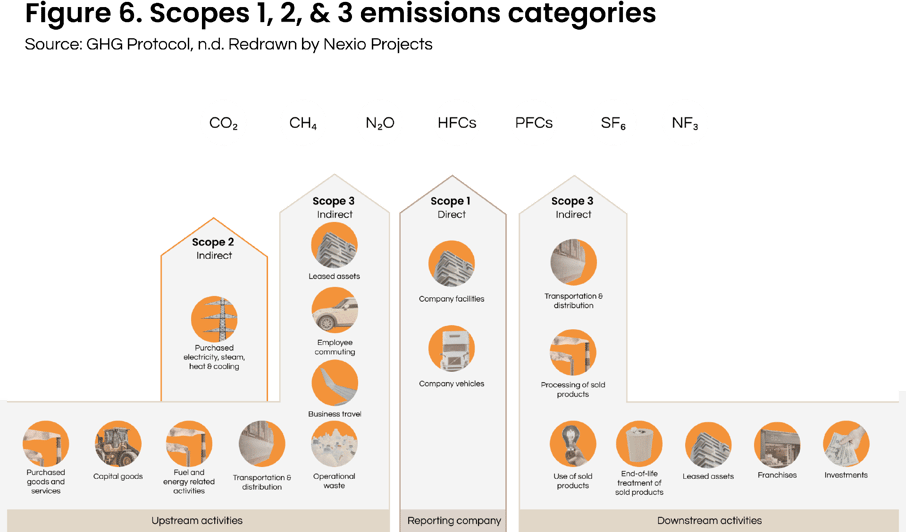
Scopes 1 and 2 are mandatory in any climate reporting standard. Scope 3 is optional but highly recommended. For many organisations, scope 3 presents a large share of their total carbon footprint.
The inclusion of scope 3 categories is based on relevance. According to the GHG Protocol, scope 3 categories are relevant if the emissions from the category:
- Are believed to be large compared to scope 1 and 2 emissions;
- Present a risk to the company through, for instance, legislation;
- Are deemed critical by stakeholders;
- Can be influenced and reduced by the organisation.
It is good practice to include as many scope 3 categories as possible and continuously expand the emissions inventory.
As scope 3 involves stakeholders throughout the value chain, it is important to engage with suppliers and customers for accurate activity data. For a more in-depth overview read “Why and How You Should Measure GHG Emissions”.
Step 2 - Set targets in line with the Paris Agreement
To meet the goals of the Paris Agreement, it is key for organisations to develop emissions reduction targets. They need to follow the trajectory to stay within 1.5°C or well below 2.0°C global warming.
Setting emissions reduction targets is an essential step on an organisation’s climate journey. It gives a specific goal to work towards and helps define the exact actions that are needed to decarbonise operations. Furthermore, setting public targets is an excellent way to show transparency and commitment. That applies to both internal and external stakeholders.
Companies demonstrating leadership on environmental and climate issues have been shown to economically outperform their peers.
To make sure targets align with the global goal, they can be verified through the Science-Based Targets Initiative (SBTi).
Setting science-based targets have been proven to help companies cut their emissions effectively.
A typical SBTi-validated company is reducing their emissions at a rate exceeding what is needed to reach the global target.
Companies with science-based targets managed to lower their emissions by 25% between 2015 and 2019. In contrast, global emissions rose by 3.4% in the same timeframe.

We advise setting climate targets that cover all 3 scopes of emissions. This means setting targets for emissions from your operations, as well as from your value chain.
Your own operations are a good place to start. But a climate leader should always be inspiring others to make a positive change as well. Moreover, engaging with your value chain is important to curb emissions from your entire carbon footprint.
Although scope 3 emissions occur outside of your operations, for a lot of organisations they make up the majority of emissions. And they are not outside of their sphere of influence (up to 90%).
The ultimate goal of setting targets and reducing emissions is reaching net zero emissions by 2050. For this, the SBTi has launched a new Net-Zero Standard. It aims to help businesses set both short- and long-term targets that are verified. They align with science and the sector-specific requirements to reach net zero by 2050.
Setting science-based targets according to this standard is necessary to make national net zero commitments a reality.
.png?width=4269&height=1110&name=Did%20you%20know%20(1).png)
Net zero refers to a condition of equilibrium between the amount of GHG emitted and the amount removed from the atmosphere.
Carbon neutral means that any CO2 emitted into the atmosphere is compensated by an equivalent amount being avoided or removed.
Step 3 - Effectively Reducing Emissions
The third step after measuring emissions and setting reduction targets in line with the Paris Agreement is to reduce emissions.
How? Include absolute emissions reductions, i.e the total sum of your organisation's emissions decreasing over time.
Emission reduction targets will give your organisation strong goals to guide all future decision-making processes and business activities.
Possibilities for reducing emissions depend largely on the company’s operations. Overall, improving energy efficiency across operations, and switching to the use of renewable energy sources are great ways to reduce emissions.
Today, more than 1250 organisations around the world have set SBTs in line with the Paris Agreement.
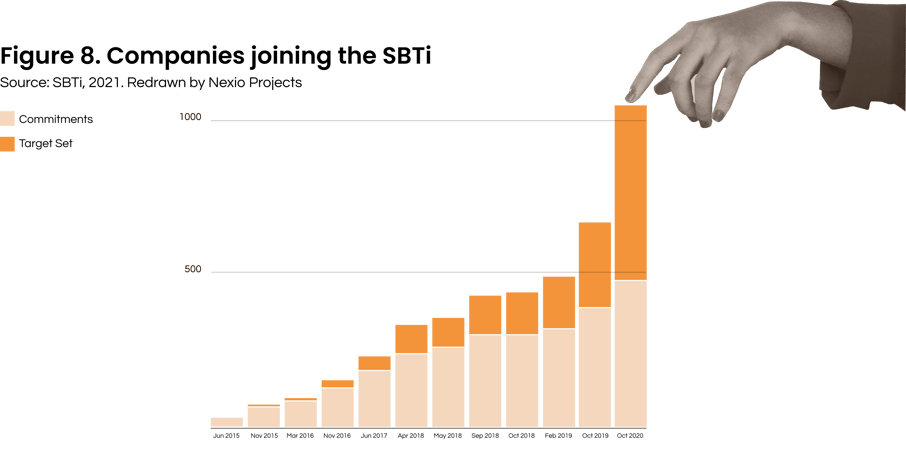
Following, we list some emission reduction opportunities to get you started:
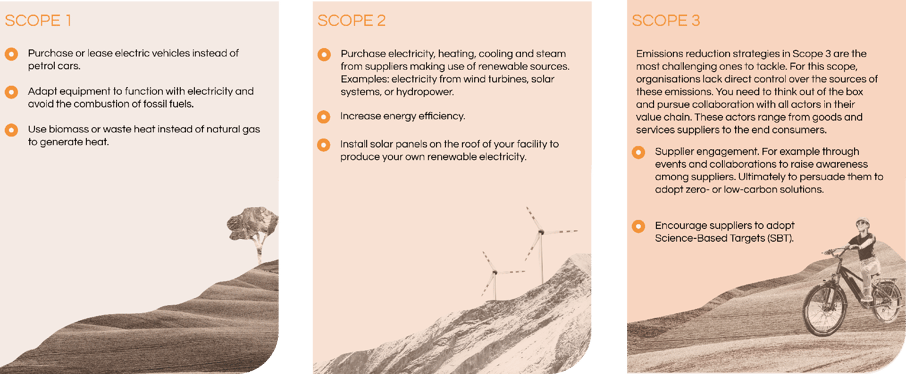
To conclude, these are key takeaways when it comes to emission reduction:
- Use resources in a more efficient way. Emissions from the extraction, processing and transport of such resources will be avoided;
- Adopt sustainability criteria into your procurement activities and purchase lower-carbon goods and services;
- Reduce emissions of employee commuting by stimulating lower-carbon modes of travel, such as public transport and cycling;
- Reduce emissions from business travel by adopting policies to limit air travel for company activities.
If you would like to read more about emission reduction, we recommend you to read our article on “Emission Reduction Strategies & How to Decarbonise”.
Step 4 - What offsetting really means
The last step of your climate strategy consists of offsetting those emissions that are inevitable for your business operations.
Offsetting emissions is the best next step after setting SBTs to balance overall greenhouse gas emissions.
This is in line with Article 6 of the Paris Agreement. Nevertheless, it should be the last step and only used to offset emissions that cannot otherwise be reduced.
In fact, not all that glitters is gold, and as much as offsetting can be an efficient strategy to compensate for the unavoidable emissions of your business activities, it has its drawbacks.
Above everything, offsetting should be seen as a last resort. If not, organisations can be discouraged to invest in direct decarbonisation.
This is true especially when offsetting projects end up being cheaper than proper decarbonisation strategies.
However, only after you have explored every opportunity to reduce emissions, should your organisation invest in offsets.
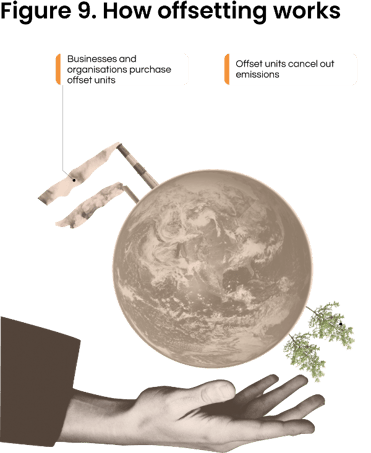
Companies and individuals can invest in environmental projects around the world to compensate for their own emissions. A carbon offset is proof of avoidance, reduction, or removal of greenhouse gas emissions elsewhere, which compensates for emissions made by the purchaser of the offset.
There are two categories of offset projects:
- Avoidance or reduction projects;
- Removal projects.
Avoidance and reduction projects are projects where emissions are avoided or mitigated where they are generated. The prevention of deforestation is one example of these projects.
Removal projects, on the other hand, support the capture and sequestration of greenhouse gas emissions. For example by planting trees or using carbon capture systems to directly remove CO2 from the atmosphere.
Carbon offsets should be seen as green investments rather than compensation strategies to reduce one’s own emissions.
When everything has been done to curb the company’s own emissions, carbon offsets might be the right way to go. It's another way to finance climate efforts and work towards the goals of the Paris Agreement.
As a ‘bonus’, credible offsets can compensate a company’s leftover emissions.
When offsetting, you should always purchase carbon offsets from certified programmes.

Offsetting Check-List
- Not all offsets are created equal: select carbon offsetting projects that have gone through proper due diligence;
- Check if the carbon credit provides information on the emissions that would occur in the absence of the proposed project. It should also have a methodology to measure emissions after the project is performed;
- Check for proof that the project would not occur without the investment raised by the sale of the carbon offset credits;
- Claimed reductions or carbon removal described by the credits should be permanent, i.e. not reversible. In the case of a tree-planting project, it should be ensured that the planted trees will not be cut;
- Offset projects should not cause emissions outside the project boundary. For example, if leakage or increased electricity need causes higher emissions elsewhere;
- Make sure that all greenhouse gases are covered, not just CO2, and that credits are expressed in kg CO2 equivalents;
- Check how the exact number of emissions reduced, avoided, or removed from the atmosphere is calculated. It should be the result of a sound formula or estimation;
- If you want to achieve net zero, then move beyond offsets based on reduced or avoided emissions. Instead, you should choose offsets that support projects that sequester greenhouse gases from the atmosphere. For example, projects with CO2 removal certificates;
- Do not skimp on your compensation. Cheaper programmes often only compensate for CO2 emissions. The complete climate effect and all greenhouse gases should be taken into account.
To read more on carbon offsetting, you can visit our blog article “A Guide to Carbon Offsetting”.
CHAPTER 4
What to Expect from Further COPs and The Upcoming COP27?
The next COP is set to take place in November this year in Sharm El-Sheikh, Egypt. This 27th summit is expected to strengthen and increase climate commitments. The outcome should shed light on the world’s path towards net zero.
As shown in the latest IPCC report, climate scientists show that effective climate action is necessary within this decade. That's the only way to keep the 1.5°C goals in sight. As it stands, we are not on track to reach net zero by 2050(F).
Despite COP26 bringing about progress toward GHG reduction, national actions and targets are still falling short of allowing the Paris Agreement’s goals to be achieved. Nations are required to update and increase the ambition levels of their NDCs annually, starting this year.
For COP27 to be a success, the updated NDCs should ramp up mitigation actions. Additionally, progress must be booked in the areas of adaptation and finance(G).
The financial pledges made at COP26 need to be backed up by firm plans by the time COP27 takes place. Next to that, the issue of loss and damage will be raised again. No agreement was reached on the compensation from rich countries to poor countries that suffer damages due to climate change(H).
Upcoming COPs might lead to agreements on the inclusion of voluntary carbon markets (VCMs) into the accounting framework of national mitigation efforts. This would allow for more flexibility for the private sector to contribute to the realisation of global climate goals.
All in all, the outcomes of COP27 are bound to increase pressures on the private sector. It also allows for more legislative frameworks to steer them in the right direction.
Hopefully, COP27 can keep up the political momentum of Glasgow and bring us closer to limiting global temperature rise under 1.5°C.
The summit will serve as another opportunity for world leaders to show climate leadership. It will again serve as a platform for all stakeholders to collaborate: governments, civil society, and the private sector.
In the end, dangerous climate change can only be averted if everyone takes responsibility.
We all need to take steps to transition to a zero-carbon economy. All the while holding each other accountable for taking ambitious climate action.
The best time for any organisation to start reducing its climate impact was yesterday. The second-best time to start is today.
Sources
A United Nations Climate Change, (n.d.). Conference of the Parties (COP). Available here.
B H. Ritchie, M. Roser, & P. Rosado, (2020). CO2 and Greenhouse Gas Emissions. Our World in Data. Available here.
C United Nations Environment Programme, (2021). Emissions Gap Report 2021: The Heat is On - A World of Climate Promises Not Yet Delivered. Available here.
D Climate Action Tracker, (n.d.). Available here.
E M. McGrath, (2022). Climate Change: Fifty-Fifty Chance of Breaching 1.5C Warming Limit. BBC News. Available here.
F IPCC, UNEP, & WMO, (2022). Climate Change 2022: Mitigation of Climate Change. Available here.
G United Nations Climate Change, (2022). More Ambitious Climate Plans Needed Ahead of COP27. Available here.
H United Nations OCHA, (2021). COP26: Was It Helpful? COP27: What to Expect? Available here.
